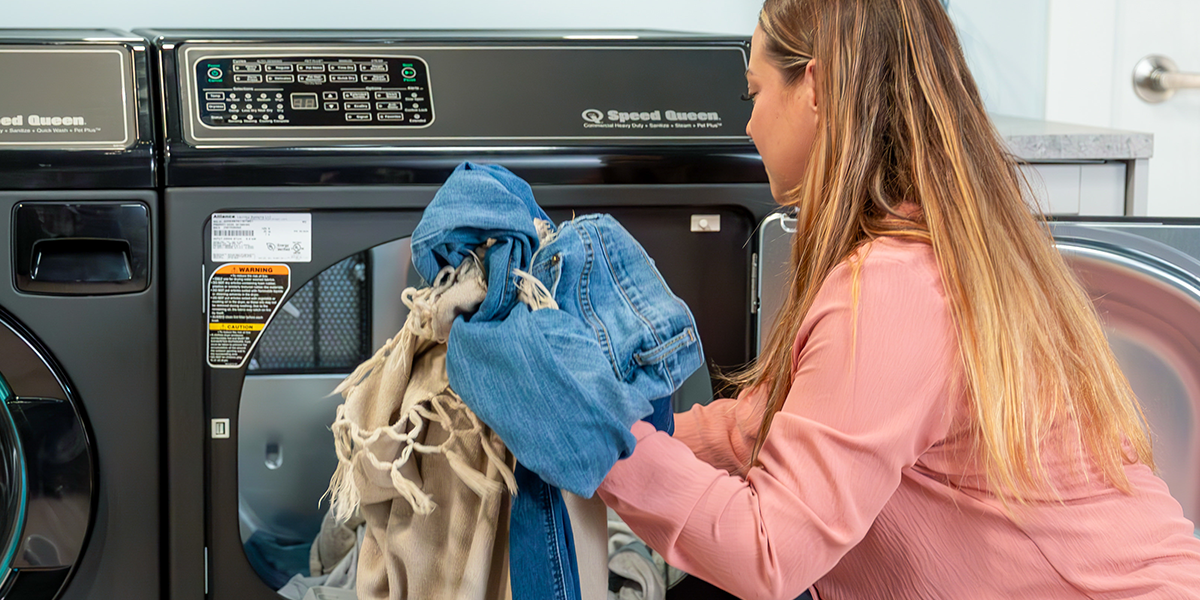When you’re in need of a piece of clothing, dryers seem to take forever. But, realistically, dryers are pretty efficient. Typically, a dryer can finish a load of clothing in about 30 to 45 minutes, but there are a lot of variables that come into play. When trying to answer the question, “How long does a dryer take?,” you’ll want to pay attention to a few variables. Load size, type of clothing, selected settings, and dryer maintenance are all factors that can affect how long it takes to dry your clothes.
Can load size affect drying time?
If you’re wondering, “How long does a dryer take?”, load size is a key factor that affects drying time. A good rule of thumb is to only fill the dryer half way. This gives the dryer contents room to tumble, enabling air to circulate throughout the dryer and touch more of the fabric’s surface. If you’re tempted to pack your dryer full, don’t do it. You’ll find inconsistent results within the load that will lead to extended drying times.
How long does a dryer take? It depends on fabric.
Yes, what you put in the dryer has an affect on drying time. Different fabrics have different weights, absorbencies, and structures—all of which tie into the time it takes to dry. Heavier, more absorbent fabrics like towels typically take longer to dry than lighter fabrics like a cotton T-shirt. Synthetic fabrics are sometimes the fastest to dry as they typically absorb less water.
How long does a dryer take? It depends on your setting choice.
Settings control temperature and load time, so they definitely impact drying. It’s best to use higher temperatures for heavier items like towels. Low to medium heat is best for sheets and blouses and underwear. And no heat settings are great for heat-sensitive fabrics like wool. If a load of laundry is taking longer than usual to dry, check the settings to make sure they align with what’s right for the fabric.
Speaking of settings, you may sometimes find that your dryer continues to run even after the load is dry. This can happen when you’ve manually selected a dryer time that’s longer than needed or because you have Extended Tumble selected, which fluffs the clothes after they are dry to prevent wrinkling.
My dryer takes a long time to dry clothes. What should I do?
If your dryer is taking a long time to dry your laundry, there are some causes that are easy to address. The following tips are things you can do that don’t require a great deal of technical knowledge.
Confirm the power source
A dryer can take longer to dry a load if it is operating from the wrong power source. A dryer should be connected to a 240-volt circuit to operate at full capacity. If it is connected to 120 volts, it will take much longer to dry a load.
Plugging in via extension cord also can reduce the amount of power your dryer receives, so it is not recommended for optimal operation.
Check for lint buildup
Drying is all about air circulation and if there is even a light layer of lint on the screen, it will impact circulation within the dryer. This (along with mitigating a potential fire hazard) is why you should always clean out the dryer lint filter after every load.
It’s important to note that lint can wind up in other places in your dryer besides in the lint filter, such as below the filter and under the dryer.
Be sure the dryer vent isn’t clogged
A clogged dryer vent can most certainly affect drying time. Lint builds up inside the exhaust vent and, in addition to being a potential fire hazard, it can restrict airflow in the dryer. If the vent needs cleaning, you can call a technician or, if you are comfortable, you can follow these steps:
- Unplug the dryer.
- Disconnect the vent hose from the dryer.
- Vacuum out the vent hose from both ends, including outside.
- Use a screwdriver to remove the exterior exhaust hood.
- Vacuum lint from the hood entrance.
- Replace the exhaust hood, reconnect the vent hose, and plug the dryer back in.
When working with the vent hose, make sure it is not pinched or crushed as this can restrict airflow and lengthen drying times.
Stay on top of dryer maintenance
If you’ve checked all of the above and your dryer is still taking a long time to dry your laundry it may require some regular maintenance.
Other dryer issues, like part malfunctions, can affect drying times and should be addressed by a service technician. The most common part malfunctions related to drying times are a broken heating element in an electric dryer or a solenoid malfunction in a gas dryer. If you check all of the likely causes for extended dryer times — like load size, dryer settings, and the condition of your lint traps and vents — to determine that none of these are inhibiting drying, we recommend you call a service technician. If your heating element or solenoids are malfunctioning, they will need to be replaced and a service professional best handles this. You can find a servicer near you at https://speedqueen.com/support/find-service/


